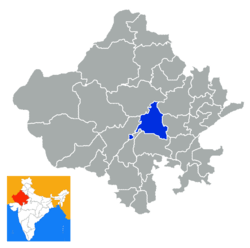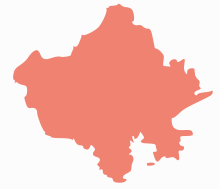Ajmer district
Ajmer District is a district of the state of Rajasthan in western India. The city of Ajmer is the district headquarters.
Ajmer district अजमेर जिला | |
|---|---|
District of Rajasthan | |
 Location of Ajmer district in Rajasthan | |
| Coordinates (Ajmer): 26°27′N 74°38′E | |
| Country | India |
| State | Rajasthan |
| Division | Ajmer |
| Headquarters | Ajmer |
| Tehsils | 1. Kishangarh, 2. Ajmer, 3. Sarwar, 4. Kekri, 5. Peesangan, 6. Nasirabad, 7. Masuda, 8. Beawar, 9. Bhinay |
| Government | |
| • District collector | Ms. Arti Dogra[1] |
| • Lok Sabha constituencies | 1. Ajmer (shared with Jaipur district), 2. Rajsamand (shared with Nagaur, Pali and Rajsamand districts) |
| • Vidhan Sabha constituencies | 1. Dudu, 2. Ajmer North, 3. Ajmer South, 4. Pushkar, 5. Kisahngarh, 6. Nasirabad, 7. Masuda, 8. Kekri |
| Area | |
| • Total | 8,481 km2 (3,275 sq mi) |
| Population (2011) | |
| • Total | 2,583,052 |
| • Density | 300/km2 (790/sq mi) |
| • Urban | 40.1% |
| Demographics | |
| • Literacy | 69.3% |
| • Sex ratio | 951 |
| Time zone | UTC+05:30 (IST) |
| Vehicle registration | RJ-01 |
| Major highways | NH 48, NH 58, NH 448 |
| Average annual precipitation | 481.3[2] mm |
| Website | ajmer |
Ajmer District has an area of 8,481 km², and a population of 2,583,052 (2011 census). Three main religions are; Hindu 1,869,044, Muslim 244,341, Jains 47,812. The district is situated in the center of Rajasthan, and is bounded by Nagaur District to the north, Jaipur and Tonk districts to the east, Bhilwara District to the south, and Pali District to the west.
Ajmer geography
The eastern portion of the district is generally flat, broken only by gentle undulations. The western parts, from north-west to south-west, are intersected by the Aravalli Range. Many of the valleys in this region are sandy deserts, part of India's Thar Desert, with an occasional oasis of cultivation. Some fertile tracts are also present; among these is the plain on which lies the town of Ajmer. This valley has an artificial lake, and is protected by the massive walls of the Nagpathar range or Serpent rock, which forms a barrier against the sand. The only hills in the district are the Aravalli Range and its offshoots. Ajmer is almost totally devoid of rivers. The Banas River touches the south-eastern boundary of the district so as to irrigate the pargana of Samur. Four small streams—the Sagarmati, Saraswati, Khari and Dai—also intersect the district.
The district is divided into four subdivisions, Ajmer, Beawar, Kekri and Kishangarh, and further subdivided into nine tehsils, Ajmer, Beawar, Bhinai, Sarwar, Pisangan, Tantoti, Nasirabad, Masuda, Kekri, Kishangarh.
Demographics
According to the 2011 census Ajmer district has a population of 2,583,052.[3] This gives it a ranking of 161st in India (out of a total of 640).[3] The district has a population density of 305 inhabitants per square kilometre (790/sq mi) .[3] Its population growth rate over the decade 2001-2011 was 18.48%.[3] Ajmer has a sex ratio of 950 females for every 1000 males,[3] and a literacy rate of 70.46%.[3]
At the time of the 2011 Census of India, 96.43% of the population in the district spoke Hindi, 1.85% Sindhi and 0.92% Urdu as their first language.[4]
| Year | Pop. | ±% p.a. |
|---|---|---|
| 1901 | 527,036 | — |
| 1911 | 543,802 | +0.31% |
| 1921 | 523,585 | −0.38% |
| 1931 | 592,464 | +1.24% |
| 1941 | 680,957 | +1.40% |
| 1951 | 818,767 | +1.86% |
| 1961 | 975,106 | +1.76% |
| 1971 | 1,145,995 | +1.63% |
| 1981 | 1,438,068 | +2.30% |
| 1991 | 1,726,531 | +1.84% |
| 2001 | 2,178,447 | +2.35% |
| 2011 | 2,583,052 | +1.72% |
| source:[5] | ||
References
- "District Administration | Ajmer, Rajasthan Official Website". Retrieved 7 July 2018.
- "Monsoon Report 2016" (PDF). Retrieved 7 July 2018.
- "District Census 2011". Census2011.co.in. 2011. Retrieved 30 September 2011.
- 2011 Census of India, Population By Mother Tongue
- Decadal Variation In Population Since 1901
- Ajmer The Imperial Gazetteer of India, 1909, v. 5, p. 137-146.
External links
| Wikimedia Commons has media related to Ajmer district. |
